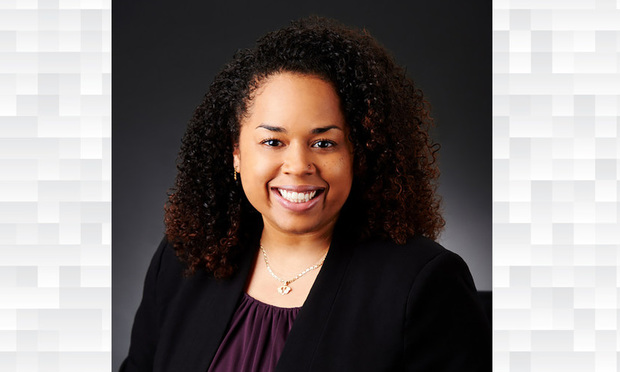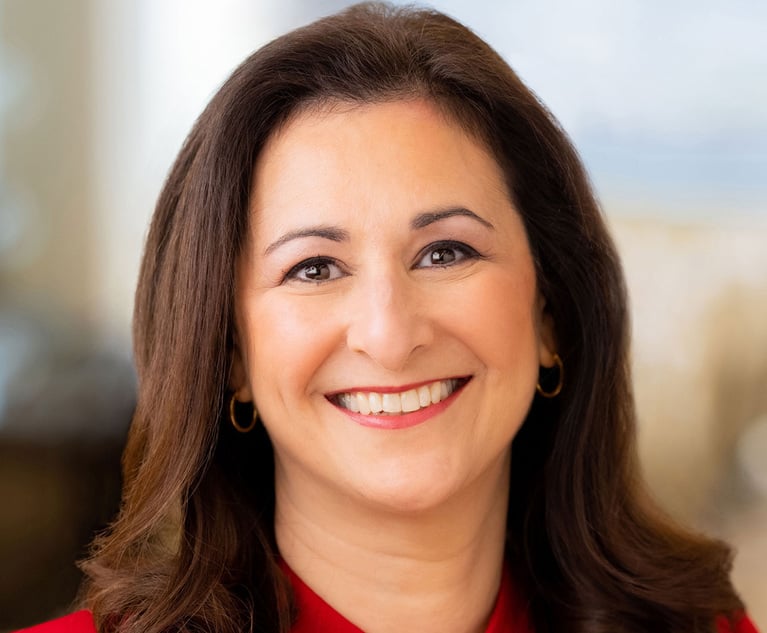Pa. Law Firms Must Learn From the Past to Improve Diversity in the Future
After nearly 175 years, there is still much progress to be made in law firm diversity. The Philadelphia legal community should not underestimate the impact changing institutions has on creating opportunity for individuals.
December 11, 2018 at 09:55 AM
12 minute read
 Tianna K. Kalogerakis.
Tianna K. Kalogerakis.
A mere four years after The Legal Intelligencer's founding in 1843, the story of blacks seeking admission to the legal profession in Pennsylvania began. Despite nearly 175 years of black Pennsylvania lawyers overcoming obstacles to entry of the legal profession, institutional barriers persist, leaving blacks and other minorities in the state still in search of meaningful access in the legal profession. In 2018, law firms that are not intentional about cultivating diversity may be unintentionally discriminating against diverse candidates.
To tell the story of diversity in the legal profession—specifically when discussing the black lawyer—one must first acknowledge the role of slavery in America. People of color were held in bondage for decades against their will and the ownership of humans by other humans was sanctioned by the laws of this country. Enslavement and discrimination of individuals based on their skin color was codified into our federal and state systems of government and dictated the daily interactions of individuals. These codifications and the resulting caste system became the foundations of the institutional barriers minorities continue to face today.
Initially, it was explicit bias that blocked blacks from entering the legal profession in Pennsylvania. In 1847, George Boyer Vashon sought admission to the Allegheny County Bar. Vashon was denied admission not because of any lack in his legal capabilities (he became the first black person admitted to the New York Bar in 1848), but because he was not a white man. Vashon was denied admission to the Allegheny County Bar a second time 20 years later in 1867. Vashon was posthumously admitted to the Pennsylvania Bar in 2010 through the efforts of his great-grandson, Nolan N. Atkinson Jr., a trailblazer in his own right who, among other notable accomplishments, helped found the Philadelphia Diversity Law Group.
In 1865, Jonathan Jasper Wright became the first black person admitted to practice law in Pennsylvania. Another factor that further limited access of black attorneys at this time was the fact that the 54 counties in existence had independent jurisdiction over admissions to their local bar. Testing and fitness standards for a candidate to pass differed from county to county, and an attorney was limited to practicing in the county in which they were admitted unless they met the requirements of admission in another county. It was not until 1902, when the Pennsylvania Supreme Court appointed the Pennsylvania State Board of Law Examiners that uniform, statewide standards for admission to the Pennsylvania Bar were established.
Following the standardization of the Pennsylvania admission process, the number of black attorneys grew slowly and inconsistently. By 1900, there were 10 black lawyers practicing in Philadelphia. From 1908 to 1920, not one black person was admitted to the Pennsylvania Bar. By 1925, the number of black lawyers in Philadelphia increased to 18. In 1927, Dr. Sadie Tanner Mossell Alexander was the first black woman admitted to the Pennsylvania Bar and remained the only black woman lawyer in Philadelphia until 1949. From 1933 to 1943, not one black person was admitted to the Pennsylvania Bar.
While the number of black lawyers in Philadelphia slowly crept upward, black Philadelphia lawyers achieved historic firsts and engineered sweeping societal change on national, local and statewide levels by challenging institutional norms. In 1948, William T. Coleman Jr. became the first black person to serve as a law clerk at the Supreme Court of the United States. In 1952, he would become the first black associate in a majority firm, Dilworth Paxson, and there became the first black partner at a majority firm in 1957. Coleman served as co-counsel with Thurgood Marshall in Brown v. Board of Education wherein the Supreme Court held that separate but equal facilities in public accommodations unconstitutional in 1954. That same year, Coleman and Raymond Pace Alexander filed a petition to desegregate Girard College which was created in 1833 by the will of Stephen Girard to benefit “poor, white orphan boys.” The quest to desegregate Girard College would take 14 lawsuits, an eight-month protest of the school led by Cecil B. Moore, and last 15 years before the Girard College Board of Trustees would vote to admit black students.
In 1950, Curtis C. Carson, Thomas Reed, Arthur Thomas, Robert W. Williams, and Charles Wright founded Barristers Club, now known as the Barristers' Association of Philadelphia Inc., which continues to serve the professional needs of black Philadelphia lawyers today. In 1951, Philadelphia became the first city in America to ban racial and religious discrimination in city employment, services and contracts by adopting the Philadelphia Home Rule Charter. Sadie Tanner Mossell Alexander is credited as the principal drafter of this provision.
In 1953, prominent black lawyer J. Austin Norris of Norris, Schmidt, Green, Harris, Higginbotham & Brown asserted that the Pennsylvania Bar examination discriminated against black applicants. A committee consisting of Abraham L. Freedman, G. Ruhland Rebmann Jr., and Theodore G. Spaulding, and Judge William H. Hastie of U.S. Court of Appeals for the Third Circuit—known as the “Hastie Committee”—was appointed to investigate racial discrimination in Pennsylvania Bar examinations and procedures. In 1954, the Hastie Committee found “no discriminatory practices” of the Pennsylvania Bar examination, but Norris remained unconvinced.
In 1970, along with Ricardo C. Jackson, then-president of the Barristers' Association, and others, Norris again argued that the Pennsylvania Bar examination process discriminated against black applicants. The Philadelphia Bar Association appointed a Special Committee on Pennsylvania Bar Admission Procedures dubbed the “Liacouras Committee” after the chair of the committee, Peter J. Liacouras, to investigate. Together, Jackson (who later became a judge on the Philadelphia Court of Common Pleas), Liacouras, then-Philadelphia Court of Common Pleas Judge Clifford Scott Green, then-Philadelphia Municipal Court Judge Paul Dandridge and W. Bourne Ruthrauff concluded that the Pennsylvania Bar exam “as developed and administered is invalid and discriminatory, and circumstantial evidence leads to the strongest presumption that blacks are indeed discriminated against when they take the exam.” Before the Liacouras Committee's report was issued, the Pennsylvania Board of Law Examiners regularly asked for pictures of each applicant and seated all of the black applicants together to take the exam. Further, 98 percent of white applicants passed the exam as compared to 70 percent of blacks.
Following the Liacouras Committee report, Nolan Atkinson Jr. and Professor Paul Bender of the University of Pennsylvania School of Law successfully negotiated with the Board to change the administration of the exam. Whereas 83 black lawyers were admitted to the Pennsylvania Bar from 1955 to 1970, as a result of the Liacouras Committee's efforts, 82 black lawyers were admitted to the Pennsylvania Bar within a mere two years of the changes in administration of the exam. The number of blacks admitted to the Pennsylvania Bar has grown steadily ever since. By 1994, there were 865 black lawyers in the City of Philadelphia and the number of black lawyers in Philadelphia is currently unknown. This initiative executed by a few organized individuals created change at the top an institution which exponentially expanded opportunities for others.
Thanks to the efforts of the black attorneys and allies mentioned and unmentioned here, black people garnered increased entry into the Pennsylvania Bar and have evidenced possibility by simply working in their respective legal capacities. Increased entry of blacks in the legal profession has also encouraged the entry and growth of other minorities into the Pennsylvania legal community. However, removing explicit bias from the institution that certified that a minority candidate is competent to practice law did not result in easier entry into law firms, which as independent institutions with their own internal systems, have struggled to recruit diverse attorneys and retain them.
By not being intentional about diversity, firms uphold the barriers to entry black Pennsylvania lawyers faced throughout history.
For 10 of its 175 years in circulation, The Legal has provided Pennsylvania lawyers with an important metric to discuss the gains (or lack thereof) in diverse plaintiffs attorneys in the state through its annual plaintiffs bar diversity survey. Loyal Legal readers reviewing these surveys yearly have likely noticed that the gains in diversity of firms measured in the survey have doubled.
It is important to note two things about the findings in these surveys. First, even though the percent of minority attorneys in the plaintiffs bar has doubled since the first survey in 2007 from 3 percent to 8 percent, the total percentage of minority lawyers of the firms surveyed has yet to reach even 10 percent. Stated another way, the total number of black, Hispanic, Asian Pacific, South Asian, and American Indian lawyers taken together do not amount to 10 percent of the plaintiffs firms surveyed. Thus, doubling the number of minorities total over a 10-year period is simply not enough. For example, blacks make up 43.9 percent of the population of Philadelphia, and the diversity of this city is not reflected in the plaintiffs bar.
The Legal surveys consistently discuss whether the path to increasing diversity at Pennsylvania plaintiffs firms should be organic or strategic. Black and minority lawyers in Pennsylvania have only begun to enter the practice of law in a ratio comparable to whites since 1970. That is 48 years of playing catch-up after starting centuries behind. Diversity is a moral imperative and enhances the range of perspective of any organization where diverse voices have a seat at the table. Firms cannot responsibly continue to rely on antiquated practices to get candidates by looking at a select few schools, finding people through word of mouth, or passively posting opportunities to fill vacancies. To increase the entry and access of minority attorneys at a more respectable pace, firms need to make institutional changes from the top of their respective organizations to recruit and retain minority attorneys, be mindful of the role implicit bias may play in filling vacancies, and actively seek diverse talent.
Diverse talent has always existed.
The pioneering black Pennsylvania lawyers mentioned or unmentioned here were exceedingly qualified to practice law. Yet, for each one of them who will be remembered for their achievements or accomplishing a “first,” how many of their qualified peers were prevented from pursuing the law altogether or not afforded a similar opportunity to prove themselves? Likely many minorities are still seeking the chance to prove themselves today. Firms looking for these qualified candidates will find them in abundance in minority bar associations.
Minority bar associations, like the Barristers Association of Philadelphia, continue to serve as resources to diverse attorneys and employers alike and are an excellent source of talent. As a benefit to our members, the Barristers Association sends employment opportunity announcements directly to our members' email at least once a week. This practice is not exclusive to the Barristers. By taking the extra step of sending job announcements to minority bar associations, employers increase their reach and improve the probability that they will have diverse candidates to interview.
To increase retention of minorities, plaintiff's firms need to support their diverse employees through business development, mentorship and creating a sense of value for the lawyer. In addition to advocating for their members and creating professional and business opportunities, minority bar associations also function as spaces where similarly situated individuals can seek advice about advancing their careers or addressing challenging dynamics with peers. Minority bar associations are also where diverse lawyers can find reassurance that they are not, in fact, alone in their experiences although they are often the only minority in their workplace. Employers can support their minority lawyers by paying their membership dues to a minority bar association and attending programming of the organization organization or offering resources to assist in executing the programming. In turn the firm benefits from the perspective of the diverse lawyer and the proven financial gains that flow from having a diverse workforce.
Entry to the profession is not the same as inclusion.
Retention of minorities is a serious growth area for firms. Black partners at large majority firms are almost nonexistent, and the numbers are mostly stagnant despite the increase of minority hires. This means black attorneys are not granted full access in the profession if they cannot reasonably expect to make it to the highest levels of their profession. To illustrate, here are the numbers of black partners over an approximate 35-year span for a few Philadelphia law firms.
| Firm | Black Partners 1984 | Black Partners 1994 | Black Partners 2018 |
| Blank Rome | 1 | 1 | 2 |
| Dechert | 0 | 1 | 1 |
| Drinker Biddle | 1 | 1 | 1 |
| Morgan Lewis | 0 | 3 | 2 |
| Pepper Hamilton | 2 | 1 | 4 |
| Schnader | 1 | 1 | 1 |
*These metrics were presented by the Tucker Law Group at the firm's CLE presentation titled, “Standing on the Shoulders: the Black Philadelphia Lawyer.”
After nearly 175 years, there is still much progress to be made. The Pennsylvania legal community should not underestimate the impact changing institutions has on creating opportunity for individuals. With institutions like the The Legal continuing to provide diversity metrics, chronicling the triumphs of black and minority Pennsylvania lawyers alike, and connecting the legal community, we can hope to keep firms accountable and accelerate progress. Talented, diverse attorneys are ready for the opportunity, firms—learn from history—switch it up and get ready for the benefits.
Tianna K. Kalogerakis, an associate at Kang Haggerty & Fetbroyt, concentrates her practice on commercial litigation and business disputes such as breach of contract, breach of fiduciary duty, and business torts. She also serves at the president of the Barrister's Association of Philadelphia, which provides a forum for discussion and dissemination of information of matters of particular interest to Black attorneys and the Philadelphia Black community at large.
This content has been archived. It is available through our partners, LexisNexis® and Bloomberg Law.
To view this content, please continue to their sites.
Not a Lexis Subscriber?
Subscribe Now
Not a Bloomberg Law Subscriber?
Subscribe Now
NOT FOR REPRINT
© 2025 ALM Global, LLC, All Rights Reserved. Request academic re-use from www.copyright.com. All other uses, submit a request to [email protected]. For more information visit Asset & Logo Licensing.
You Might Like
View All


AI and Social Media Fakes: Are You Protecting Your Brand?

Neighboring States Have Either Passed or Proposed Climate Superfund Laws—Is Pennsylvania Next?
7 minute readTrending Stories
- 1Exceptional Growth Becoming the Rule? Demand and Rate Hikes Drove Strong Year for Big Law
- 2Dentons Taps D.C. Capital Markets Attorney for New US Managing Partner
- 3Auto Dealers Ask Court to Pump the Brakes on Scout Motors’ Florida Sales
- 4German Court Orders X to Release Data Amid Election Interference Concerns
- 5Litigation Trends to Watch From Law.com Radar: Suits Strike at DEI Policies, 'Meme Coins' and Infractions in Cannabis Labeling
Who Got The Work
J. Brugh Lower of Gibbons has entered an appearance for industrial equipment supplier Devco Corporation in a pending trademark infringement lawsuit. The suit, accusing the defendant of selling knock-off Graco products, was filed Dec. 18 in New Jersey District Court by Rivkin Radler on behalf of Graco Inc. and Graco Minnesota. The case, assigned to U.S. District Judge Zahid N. Quraishi, is 3:24-cv-11294, Graco Inc. et al v. Devco Corporation.
Who Got The Work
Rebecca Maller-Stein and Kent A. Yalowitz of Arnold & Porter Kaye Scholer have entered their appearances for Hanaco Venture Capital and its executives, Lior Prosor and David Frankel, in a pending securities lawsuit. The action, filed on Dec. 24 in New York Southern District Court by Zell, Aron & Co. on behalf of Goldeneye Advisors, accuses the defendants of negligently and fraudulently managing the plaintiff's $1 million investment. The case, assigned to U.S. District Judge Vernon S. Broderick, is 1:24-cv-09918, Goldeneye Advisors, LLC v. Hanaco Venture Capital, Ltd. et al.
Who Got The Work
Attorneys from A&O Shearman has stepped in as defense counsel for Toronto-Dominion Bank and other defendants in a pending securities class action. The suit, filed Dec. 11 in New York Southern District Court by Bleichmar Fonti & Auld, accuses the defendants of concealing the bank's 'pervasive' deficiencies in regards to its compliance with the Bank Secrecy Act and the quality of its anti-money laundering controls. The case, assigned to U.S. District Judge Arun Subramanian, is 1:24-cv-09445, Gonzalez v. The Toronto-Dominion Bank et al.
Who Got The Work
Crown Castle International, a Pennsylvania company providing shared communications infrastructure, has turned to Luke D. Wolf of Gordon Rees Scully Mansukhani to fend off a pending breach-of-contract lawsuit. The court action, filed Nov. 25 in Michigan Eastern District Court by Hooper Hathaway PC on behalf of The Town Residences LLC, accuses Crown Castle of failing to transfer approximately $30,000 in utility payments from T-Mobile in breach of a roof-top lease and assignment agreement. The case, assigned to U.S. District Judge Susan K. Declercq, is 2:24-cv-13131, The Town Residences LLC v. T-Mobile US, Inc. et al.
Who Got The Work
Wilfred P. Coronato and Daniel M. Schwartz of McCarter & English have stepped in as defense counsel to Electrolux Home Products Inc. in a pending product liability lawsuit. The court action, filed Nov. 26 in New York Eastern District Court by Poulos Lopiccolo PC and Nagel Rice LLP on behalf of David Stern, alleges that the defendant's refrigerators’ drawers and shelving repeatedly break and fall apart within months after purchase. The case, assigned to U.S. District Judge Joan M. Azrack, is 2:24-cv-08204, Stern v. Electrolux Home Products, Inc.





